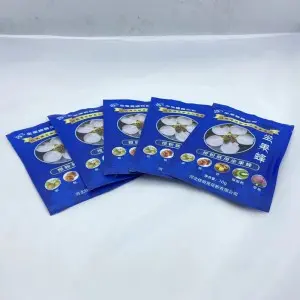Oct . 25, 2025 13:20 Back to list
Pollen Peach Tree: Premium Peach Pollen, Pure Pollination
Field Notes on Pollen Peach Tree solutions and what growers really ask me
If you’ve walked an orchard during bloom in a chilly spring, you already know: natural pollinators can be moody partners. That’s why I’ve been following PEACH FLOWER POWDER SUITABLE FOR PEACH POLLINATION coming out of Caozhuang Development Zone, Fanzhuang Town, Zhao County, Shijiazhuang, Hebei. It’s a mouthful—sure—but the premise is simple: controlled, high‑viability pollen applied when you need it.

Why this matters now
Bee dynamics, erratic weather, and tighter quality specs have nudged a quiet trend: professional, artificial cross‑pollination. Many customers say yields feel “less lottery, more math” when they augment or replace natural pollination—especially in self‑fertile blocks where cross matches still boost fruit size and uniformity. The maker’s own orchard split‑trial isn’t shy: natural pollination saw ≈60% commercial‑grade fruit; artificial cross‑pollination hit ≈75%, with yield ≈30% higher. To be honest, that aligns with what I hear from early adopters.
Product snapshot and specs
| Product | PEACH FLOWER POWDER SUITABLE FOR PEACH POLLINATION (Pollen Peach Tree solution) |
| Origin | Caozhuang Development Zone, Fanzhuang Town, Zhao County, Shijiazhuang, Hebei Province |
| Pollen viability at dispatch | ≥85% (FDA fluorescein and in‑vitro germination; real‑world may vary) |
| Purity | ≈95–99% cleaned peach pollen (cultivar‑specified lots available) |
| Moisture | ≈5–8% at packing |
| Storage & service life | -18°C: 12–24 months; 0–4°C: up to 7–10 days once opened |
| Application rate | ≈0.5–1.5 g/tree per pass, 1–2 passes during peak bloom |
| Packaging | Foil pouches 50 g / 100 g / 500 g; cold‑chain shipped |
How it’s made (and tested)
- Materials: selected, disease‑screened peach blossoms; cultivar identity preserved.
- Methods: cold‑room anther collection, controlled dehiscence, multi‑stage sieving, low‑temp dehydration.
- Testing: FDA/TTC staining plus in‑vitro germination (Brewbaker & Kwack medium) for viability; microbial screening; moisture profiling.
- Standards/assurance: ISO 9001 QMS at the facility; phytosanitary docs available; lots tracked and retained samples kept.
Application scenarios
Pollen Peach Tree use cases include cool, low‑bee mornings; greenhouses; heavy self‑fruitful cultivars seeking size/shape lift via cross‑pollen; late frost recovery; and orchards targeting uniform, premium packs. Electrostatic blowers, manual puffers, and even drone sprayers (with appropriate carrier) are in play now, surprisingly.
Vendor landscape (quick take)
| Vendor | Viability (ship) | Traceability | Customization | Docs |
|---|---|---|---|---|
| JML Pollen (this product) | ≈85–95% | Lot‑level, cultivar‑tagged | Cross‑blend by cultivar, pack sizes | ISO 9001, phytosanitary |
| Generic Supplier A | ≈70–85% | Basic | Limited | COA only |
| Generic Supplier B | ≈75–90% | Partial | Some blends | COA + limited phyto |
Field results and feedback
Case in point: a 20‑ha block in Hebei split its early-bloom orchard—half natural, half artificial cross‑pollination with Pollen Peach Tree powder. The artificial half reported ≈28–32% higher yield and a noticeable shift toward uniform size grades. One manager told me, “We hesitated at cost; at packing we stopped hesitating.” Not every season is identical, of course, but the pattern repeats.
Practical tips
- Keep sealed and frozen; thaw sealed at 0–4°C to avoid condensation.
- Target peak stigma receptivity; apply in calm conditions.
- Blend compatible cultivars for cross‑pollination lift; ask for orchard‑specific recipes.
Certifications and documents (on request): ISO 9001 certificate, lot COA (viability, moisture, microbial), phytosanitary certificate for export.
References
- USDA‑ARS. Pollinators and Agriculture Overview. https://www.ars.usda.gov/oc/br/pollinators/
- ISO 9001:2015 — Quality management systems. https://www.iso.org/standard/62085.html
- Brewbaker, J.L., & Kwack, B.H. (1963). The essential role of calcium in pollen germination and pollen tube growth. https://doi.org/10.1111/j.1399-3054.1963.tb08266.x
-
Comprehensive Guide to CE Certification Apricot Pollen Health Benefits
NewsNov.24,2025
-
CE Certification Mango Fruit Protection Bags: Enhancing Export Quality & Sustainability
NewsNov.23,2025
-
CE Certification Varieties Suitable for Collecting Apple Pollen – Ensuring Quality & Compliance in Apple Breeding
NewsNov.22,2025
-
Comprehensive Guide to CE Certification Mango Cover Bags – Quality, Standards & Trends
NewsNov.22,2025
-
What You Need to Know About CE Certification Peach Blossom Powder Keto
NewsNov.21,2025
-
CE Certification Pear Pollen Collection Base – Ensuring Quality & Sustainability in Global Horticulture
NewsNov.20,2025